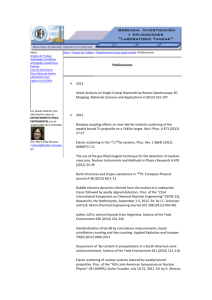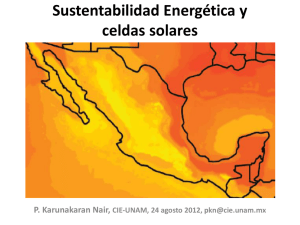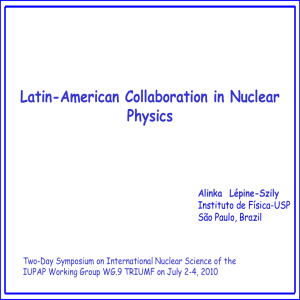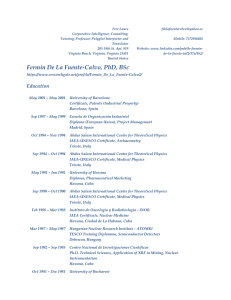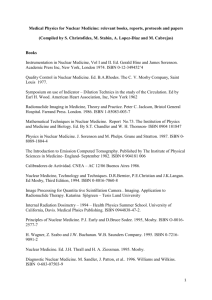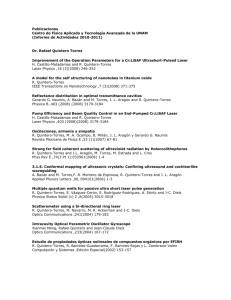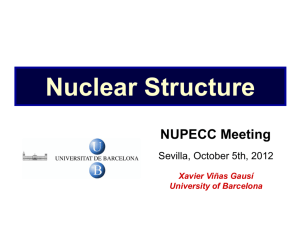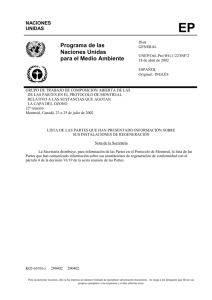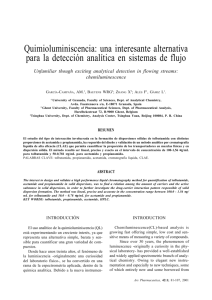alafna - NuPECC
advertisement
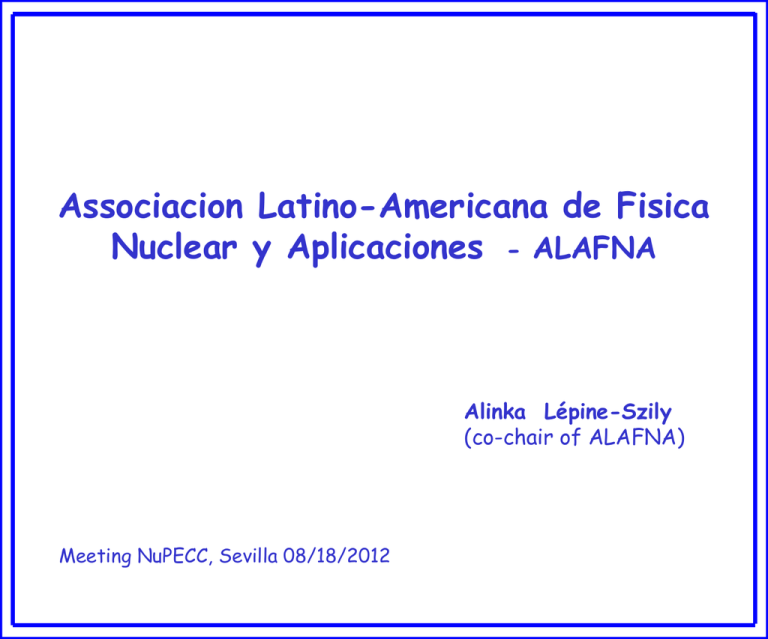
Associacion Latino-Americana de Fisica Nuclear y Aplicaciones - ALAFNA Alinka Lépine-Szily (co-chair of ALAFNA) Meeting NuPECC, Sevilla 08/18/2012 CHART OF SANTIAGO The “Association of Latin American Nuclear Physics and Applications” (ALANFA) was formed in Santiago, Chile on Dec. 19, 2009, by representatives of Argentina, Brazil, Chile, Colombia, Mexico, Peru and Venezuela. In Spanish is called “Asociación Latino Americana de Física Nuclear y Aplicaciones” ALAFNA In Portuguese is called “Associação Latino Americana de Física Nuclear e Aplicações” ALAFNA Chairs of ALANFA: Andrés Kreiner (Argentina) Alinka Lépine-Szily (Brazil) Steering Committee (SC) of ALAFNA is formed by the 15 original founders: Ricardo Alarcon (Arizona State Univ., USA) Hugo Arellano (U. of Chile, Chile) Haydn Barros (U.Simon Bolivar, Venezuela) Maria Ester Brandan (UNAM, Mexico) Roelof Bijker (UNAM, Mexico) Laszlo Sajo Bohus (U.Simon Bolivar, Venezuela) Fernando Cristancho (UNal, Colombia) Paulo Gomes (U. Fed. Fluminense, Brazil) Carlos Granja(Inst.Exp.Appl.Phys. Czech Tech.U. Czech Rep.) Andrés Kreiner (Tandar, CNEA, Argentina) Chair Alinka Lépine-Szily (USP, Brazil) Chair Rubens Lichtenthäler (USP, Brazil) Modesto Montoya (Inst. Per. Em. Nucl., Peru) Roberto Morales (U. of Chile, Chile) Alberto Pacheco (Tandar, CNEA, Argentina) Objectives of ALAFNA To strengthen ties among the Latin American Communities doing nuclear research and applications to foster collaborations and promotion of activities, To educate the scientific community and the general public through the promotion of nuclear physics and the peaceful uses of nuclear technology, To do periodic overall assessments of nuclear science in Latin America in the context of world wide activities, and To discuss at a multi-national level future planning of nuclear science activities in Latin America Role of the Steering Committee: -establishment of ALAFNA governance rules -divulgation of ALAFNA in the scientific community -divulgation of ALAFNA within governments of Latin America with interest in nuclear science and applications ALAFNA homepage was installed on the website of the IX Latin American Symposium on Nuclear Physics and Applications” (LASNPA) july 18-22,2011, Quito, Ecuador http://www.lasnpa-quito2011.org/alafna.org 07/22/2011: ALAFNA meeting after IX Latin American Symposium on Nuclear Physics and Applications (LASNPA). Agenda: Bylaws of ALAFNA The bylaws of the Association were discussed by all presents. Some conclusions: The association should be open to all nuclear scientists of the region (different from ANPHA or NUPECC) The executive board should have 1 representative of each member country. Proposal of Chile and Venezuela: Alafna should promote education for general public and schools on all levels, to compensate the negative effect on the general publics perception on nuclear science due to the Fukushima accident. Agenda: ANDES project Construction of an underground laboratory with international visibility in the tunel Agua Negra, between Argentina and Chile, below the Andes. Situated between 3.5-5km on Argentinian side, Thickness of the rock >1500 m. Situated between 3.5-5km on Argentinian side, Thickness of the rock >1500 m. The present members have discussed the project and those of the steering commitee voted in favour of an endorsement. However there is a worry about the cost of the project and the maintenance of the present funding of existing projects. Also it was stated that the project should benefit the local and regional technological developement. Accelerator developement-Tandar Common activities since the last meeting (Dec. 19, 2009) - Adoption of the Chart of Santiago (January 2010) - July 2-4, 2010 two-Day Symposium on International Nuclear Science of the IUPAP Working Group WG.9 at TRIUMF - July 10, 2010: National Academy of Sciences (NP2010) Text in the final report -July 2011 IX Symposium under the auspices of IUPAP (Quito) -July 2011 Presence at IUPAP WG9 meeting on 07/24/2011 at MIT -February 2012, Experimental Nuclear Physics Summer School at USP with expressive latin american participation. -August 2012 Presence at IUPAP WG9 meeting on 08/18/2012 at RIKEN -October 2012 Presence at NuPECC meeting Sevilla. -26-30 Nov. 2012 Andean School “Nuclear Physics in the 21st century” in Bogota, Colombia. Latin American Symposia on Nuclear Physics and Applications 1995 1997 1999 2001 2003 2005 2007 2009 2011 2013 Caracas, Venezuela Caracas, Venezuela San Andrés, Colombia Ciudad de México, México Santos, Brazil Iguazu, Argentina Cuzco, Peru Santiago, Chile Quito, Ecuador Montevideo, Uruguay Scope: the dissemination of the major theoretical and experimental advances in the field of nuclear science and its applications. The main topics to be covered are: Nuclear Structure and Reactions, Nuclear and Particle Astrophysics, Cosmic Rays, Hadron Structure and Phases of Nuclear Matter, Tests of Fundamental Symmetries and Properties of Neutrinos, Nuclear Instrumentation and Facilities: Radiation Detectors and Sources, and Applications in Medicine (Biomedical Imaging, Radiotherapy),Art/Archeology, Energy, Space and International Security. Scientific Program of the IX LASNPA Copiar o pdf fa website do simp. Number of participants: 120 Less than in Chile (170), due to less local Participation, air fares expensive from Brazil and Argentina, higher fee. Next Symposium dec. 2013-Montevideo -Uruguay 31 plenary talks 58 talks in parallel sessions http://videos.physics.asu.edu/LatinIX/program-IX-Latin-June30.pdf Number of participants: 125 Less than in Chile (170), due to less local participation, air fares expensive from Brazil and Argentina, higher fee. Next Symposium dec. 2013-Montevideo -Uruguay General Informations on the status of Nuclear Physics in Argentina Brazil Chile Mexico Venezuela Ecuador Colombia Peru Nuclear Physics and Applications in Argentina and Cooperation in Latin America A.J.Kreiner1,2,3. 1Departamento de Física, CNEA, Atomic Energy Commission Arg. 2Escuela de Ciencia y Tecnología. Universidad de San Martin, Arg. 3CONICET (National Research Council), Argentina. Major facility: TANDAR 20 MV Tandem (Pelletron) Facility's major experimental instrumentation and its capabilities: • - QDD magnetic spectrometer. • - Microbeam facility (beam spots of about 1μ2) with high resolution X-ray detection. • - External beam irradiation facility with on-line dose determination. • - Heavy-ion identification based on a time-of-flight facility (start and stop signals derived from microchannel plates) followed by a Bragg spectrometer or solid state detectors. • - 30-inch diameter multipurpose scattering chamber. • - Irradiation chamber for the simulation of outer-space environmental conditions. • Ion implanter. • Number of actual, active users of the facility: 51 • Number of a) permanent staff, as scientific, technical, and administrative staff, employed by the lab: 46 and b) temporary staff (including graduate students and postdoctoral researchers on the facility’s payroll): 12 Research Programs The main experimental and theoretical research lines related to Nuclear Physics and its applications are the following: • Low-energy nuclear physics: Nuclear structure, nuclear reactions, collective nuclear excitations and giant resonances, break-up reactions and their influence on fusion reactions involving weakly bound nuclei; fusion barrier distributions. • High-energy nuclear physics: Hadronic models based on QCD. Phase structure of strong interactions. Other CNEA centers • 1.2 EZEIZA Atomic Center: Isotope production (40 MeV proton Cyclotron). Nuclear metrology (radiation measurements, standards for gammas, betas, neutrons). Reactor physics (RA-3 research reactor). BNCT with reactors. 60Co irradiators. Isotope production. (150 people). • 1.3 BARILOCHE Atomic Center: Neutron physics (electron LINAC for neutron production thru photonuclear reactions, 10 people). Reactor physics and engineering RA-6 (School of Nuclear Engineering). Clinical trials in BNCT (4). Auger physics (4). • 1.4 School of Nuclear medicine (Mendoza). PET center in association with National Cancer Institute (Buenos Aires). NUCLEAR PHYSICS RESEARCH IN BRAZIL Alinka Lépine-Szily Number of scientists and graduate students in In Nuclear Physics in Brasil in 2010 2005 (underestimated) 96 25 170 291 2005: 2009: 1999: 2004: 2009: 63 universities 131 universities (http://www.universidades.com.br/brasil.htm) 2.7 millions of students, 6.9% 4.16 millions of students 4.88 millions of students, 13.9% SP Major Facility for Nuclear Physics research 8 MV Pelletron Tandem University of São Paulo: Institute of Physics 8 MV tandem 3-5 MeV.A RIBRAS Local facility: Very important for graduate student training, 56 MS and PhD thesis in last 10 years Facility´s major experimental instrumentation and capabilities: 1. Radioactive Ion Beam Brasil (RIBRAS) 2 superconducting solenoids can select and focus radioactive beams produced by transfer reactions B=6.5T. 6He,8Li,7,10Be,8B,17,18F etc beams. 2. Two large position sensitive neutron detectors (Neutron wall) 3. Gamma-ray+charged particle spectrometer (SACI-PERERE) 4. Enge split-pole spectrometer 5. Multi-purpose scattering chamber. 6. Large scattering chamber Research Programs: Low-energy nuclear physics:T,E Low energy reaction and structure studies with stable and radioactive beams, break-up, fusion, nuclear astrophysical reactions, Gamma-spectrosopy, nuclear structure with light-ion transfer reactions. T: 3-body description of halo nuclei, fusion models for superheavies, weak-interaction for r-process High-energy nuclear physics: Theory: Hadronic models in QCD, Phases of nuclear matter, nuclear astrophysics within relativistic models(hadronic and quark stars), 1111118th 118th Intn Few-Body Problems in PhysIcs 8th International IUPAP Conference on Few-Body Problems in PhysIcs Experimental: Auger project STAR collaboration at RHIC, Alice collaboration at LHC PHENIX collaboration at RHIC, Atlas collab. at LHC Highlights of recent results from RIBRAS, first and unique radioactive facility in Latin America -elastic scattering of halo nuclei on light, medium mass, heavy nuclei 6He +9Be ,27Al, 51V,120Sn, 7Be + 9Be, 51V,8Li + 9Be, 51V 8B + 27Al, 8Li, 7Be , 10Be on 12C ,8Li + p, 6He + p Resonant transfer reactions :p(8Li,4He)5He p(8Li,4He)5He R-matrix fits Ecm(MeV) Main Institutions: 1. São Paulo state (80% experimental, 35% theoretical - activity) São Paulo USP E, T research in low, high energy nuclear physics IFT/UNESP Hadronic models in QCD, 3-body models of halo nuclei T ITA 3-body models of halo nuclei , relativistic nuclear structure T Unicamp; Auger project, RHIC, LHC E IPEN: gamma spectrosopy, instrumentation and applications E 2. Rio de Janeiro UFRJ Theoretical studies of Nuclear Reactions, Hadron Physics T UFF Low energy Nuclear Reactions T,E AMS E CBPF Hadron Physics, fusion models for SHE, r-process T 3. Southern states, Paraná, UEL, applications, Gamma and X-ray spectrometry for material analysis E Santa Catarina, UFSC nuclear astrophysics within relativistic models(hadronic and quark stars) T Rio Grande do Sul, UFRGS, FURG hadron physics using QCD T International Collaborations: Experimental: 1.Strong collaboration between Pelletron (USP) -Tandar Argentina and UFF (Niteroi, Brasil) Pro-Sul CNPq-CONICET 2. STAR, PHENIX collaboration at RHIC 3. Alice collaboration at LHC 5. Collaborations: Legnaro, Catania, Sevilla, Madrid, U. Notre Dame, CNS-U.Tokyo, GANIL, ANU Theory: U.La Plata (Arg.), Cuba, U. Coimbra, Tandar, National Astronomical Observatories, Chinese Academy of Sciences , Oxford Univ., Univ. Tennessee, Univ. Sydney, Univ. Aarhus. Difficulties: Small groups, Heavy travel expenses, little money for graduate students Funding: Brazil Federal Funding Agency: Conselho de Desenvolvimento Cientifico e Tecnologico (CNPq ). State funding agencies: Ex: Fundacao de Amparo a Pesquisa de Estado de Sao Paulo (FAPESP). ~50 M$/year, 2.5M$/year for Nuclear Physics, (include grants, student fellowships, does not include salaries, which are paid by Univ, Intitutes) Science without Frontiers: 200.000 undergraduate students/year are being t for 1 year abroad. Funding: less in other Latin American countries Future projects in Brazil: RMB (Multipurpose Research Reactor) of 30MW for radioisotope production and applications, Argentinian-Brazilian collaboration OPAL reactor, totally funded 900MR$=350MEuro XXXV Nuclear Physics Workshop in Brazil 2-6 september 2012, Maresias, Brazil 24 plenary talks (14 international), 191 participants, Parallel session, posters New 14C-AMS facility installed at Universidade Federal Fluminense, Niteroi, Brazil . First in South America. Nuclear Physics in Chile Roberto Morales Universidad de Chile UNIVERSITY OF CHILE VAN DE GRAAFF LABORATORY Acelerador Van de Graaff. 3.75 MeV Sistemas de espectroscopía gamma, rayos X, alfa P.A. Miranda, M. A. Chesta, S. A. Cancino, J. R. Morales, M. I. Dinator, J. A. Wachter and C. Tenreiro Nuclear Instruments and Methods in Physics Research B 248 (2006) 150-154 Recursos humanos.-´ Investigadores Universidad de Chile Arellano, Hugo Cancino, Simón Dinator, Maria I. Morales, J. Roberto Miranda, Pedro Dr. M.Cs. M.Cs. Dr. Dr. UCH UCH UCH UCH UCH Colaboradores Robert Flocchini. Javier Miranda. Andrea Seelenfreund. Rafael Correa. Sergio Montes. Claudio Tenreiro. Mario Ávila. Raúl Morales. Margarita Préndez. Diego Salazar. Raúl Muñoz. UC Davis, California, U.S.A. UNAM, México. Universidad Academia de Humanismo Cristiano Universidad Tecnológica Metropolitana Universidad de Santiago Universidad de Talca Comisión Chilena de Energía Nuclear Fac. Ciencias, Universidad de Chile Fac. Ciencias Química y Farmacéutica. U. de Chile Fac. Ciencias Sociales. U. de Chile Fac. de Ciencias Físicas y Matemáticas. U. de Chile * Nuclear Physics in Mexico Roelof Bijker and María Ester Brandan UNAM Experimental facilities • 6 MV Tandem (ININ) • 0.7 and 5.5 MV Van de Graaf and 3 MV Pelletron (IFUNAM) • Instrumentation laboratories – Pyramid of the Sun and HAWC (IFUNAM) – Detector lab (ICNUNAM) – Instrumentation labs (Puebla and UMSNH) Where? • UNAM, DF, Instituto de Física, Instituto de Ciencias Nucleares, Fac de Ciencias • ININ and Univ. Autónoma del Estado de México, Toluca • Cinvestav, DF y Mérida • Universidad Veracruzana, Xalapa • Benemérita Universidad Autónoma de Puebla, Puebla • Universidad Michoacana San Nicolás de Hidalgo, Morelia • Universidad Autónoma de Zacatecas, Zacatecas • Universidad Autónoma de Sinaloa How many? • About 20 (10) in basic research and its instrumentation • About 30 (10) in applied nuclear physics and its instrumentation • Graduate students: About 50 Subjects: Basic science • Nuclear structure (symmetries, cluster models, nuclear masses, double b decay) T • Hadronic physics (LE QCD, quark models) T • Cosmic rays (Pyramid of the Sun, HAWC) E • Neutron physics, fundamental symmetries E • International collaborations: T, E – – – – ALICE (IFUNAM, ICNUNAM, Cinvestav, BUAP, UAS) Auger (ICNUNAM) RIB ORNL, Notre Dame (IFUNAM, ICNUNAM) LANL (IFUNAM) Subjects: Applied science • Medical physics (IFUNAM, ICNUNAM, School of Medicine UNAM, UAZ) E • Radiation physics E – RBS, PIXE, other techniques Nuclear Physics and Applications in Ecuador Institutions / activity www.epn.edu.ec Escuela Politécnica Nacional (EPN), Quito Dept. de Física y Astronomía Dept. de Ciencias Nucleares linac Co irradiator Universidad San Francisco de Quito, Quito • Bulk irradiations (electron, gamma) • Atomic absorption (X-rays, UV) • Fluorescence and mass analysis • Particle physics (D0 Fermilab) www.usfq.edu.ec „National Bureau of Control, License and Studies of Nuclear Sciences“ (former Atomic Energy Commission) Dependency of the Ministry of Electricity and Renewable Energy Laboratories (e.g. Dosimeter and radiation monitor calibration). Oncology Society SOLCA, Quito commercial radiotherapy linacs (e–,g) Hospitals (oncology), Quito, Guayaquil commercial radiotherapy linacs (e–,g) www.meer.gov.ec • Regulations, safeguards • Nuclear techniques (element analysis) • Medical Physics • Radiotherapy (electron, photon) www.solca.med.ec • Radiotherapy treatments (electron, photon) Nuclear Physics in VENEZUELA Universidad de los Andes LASER Spectrometer δ18 High Energy Group (3 Ph.D) Dr. Luis Nuñez Hydrogeology Group (2 Ph.D) Dr. Hervé Jegat OIEA I.V.I.C. 60-Co Irradiation Facility. Ing. Paolo Traversa Secondary Calibration Lab. Dr. Lila Carrizalez Medical Physics Masters Courses Official National Training Courses in Radioprotection Environmental Radioactivity Universidad Central de Venezuela Medical Physics Masters Courses. Dr. Rafael Martín (20-25 students / year) Lab. Applications Nuclear Tech. In Industry. Dr. Héctor Constan. (L.Cintillation) Ministery of Energy Comisión Nacional de Energía Atómica, National Nuclear Authority. Dr. Héctor Constan Regularions & Permissions. Training (Through IAEA) Monitoring for evaluations and permissions (Gamma Spectroscopy). Univ. Centro Occ. Lizandro Alvarado TXRF – Chemistry Department. Dra. Lué Meru Marco Hospitals & Private Centres Ciclotron (18F), PET, LINAC, Gamma Ch., MRI, CT, etc. Dra. Aisa Manzo Universidad Simon Bolivar (www.nuclear.fis.usb.ve) Last Five years Researchers 8 New Professionals 29 Prof. L. Sajo-Bohus Ph.D. Physics 2 Prof. E. Greaves M.Sc. Physics 2 Dr. P. Nemeth M.Sc. Chemistry 2 Prof. J. Liendo M.Sc. Eng. Electronic 1 Prof. D. Palacios B.Sc. Physics: 12 Prof. H. Barros B.Sc. Chemistry 5 Prof. M. Bernal B.Sc. Biology 1 Prof. F. Rodríguez Electric & Electronic Eng. 6 Support Staff 3 Postgraduate abroad 12 Techniques and devices Ion Implanter (0,4 MeV) Neutron Source (Cf) Alpha (Si) & Gamma Spectrometry (HPGe) TXRF & DRX TLD and SSNTD Co & Cs intense sources BGO, NaI(Tl) and Cherenkov Abroad NAA 2 Tech. + 1 Adm. Ion Beam Analysis Students 8 Ph.D. 5 M.Sc. 6 B.Sc. 5 AMS, ICPMS & TIMS OIEA Física nuclear y aplicaciones en el Perú El Instituto Peruano de Energía Nuclear (IPEN) cuenta con un reactor de investigación de 10 MW, en el cual se produce radioisótopos para medicina y se realiza análisis químicos por activación neutrónica. Se tiene también una facilidad de neutrografía. El IPEN en colaboración con la Universidad Nacional de Ingeniería se realiza simulación de experimentos de fisión y experimentos de física de reactores. Un grupo de la Pontifica Universidad Católica del Perú trabaja en el experimento ALICE con el grupo de México en el CERN. Conclusions: Most countries in the region have small activity in basic Nuclear Physics research. Mostly radiation and medical applications. Very small number of scientists (each country <20). Exceptions: Argentina (130), Brazil (400), Mexico(100), including graduate students. Region has no large scale facilities in NP, but intense activity around smaller facilities, large number of students. Small support from funding agencies even for maintenance of existing facilities. Thank you for your attention
